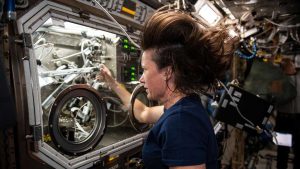
The ISS was designated as a U.S. National Laboratory in 2005 by Congress – it’s responsible for managing all non-NASA research, officially enabling space research and development access to commercial, academic, and government users.
In-space production
In-space production applications is a strategic focus area for the ISS National Lab, it highlighted, and projects should “bring value to humanity and enable business models in low Earth orbit (LEO)”.
“Proposals should demonstrate space-based manufacturing and production activities that not only enable new business growth and capital investment but also represent scalable and sustainable market opportunities,” writes the organisation. “These endeavors should produce reoccurring value with the potential to generate demand for and revenue from access to LEO.”
“Selected flight projects may be awarded funding to support project development and mission integration and operations for research that will be implemented on the space station.”
The ISS National Lab will host a webinar on 25 March 2024 to discuss ISS facilities and capabilities associated with the research announcement. Concept Summaries have to be submitted by 2 May 2024, and then Full Proposals (from those invited to submit by the The Center for the Advancement of Science in Space (CASIS), working in coordination with NASA) will be due by 8 July 2024.
The amount of funding has not been disclosed.
Optical fiber
Flawless Photonics and its investigation into optical fiber was cited as an example of a recent in-space production application that was awarded through a prior ISS National Lab opportunity.
The project in question aims to improve optical fiber production in space, to validate the company’s technology for manufacturing high-value glass materials, like ZBLAN, in microgravity.
Preliminary results, say the Laboratory, indicate promising improvements in the quantity of optical fiber produced. Apparently, it benefitted from refinements in process control during the manufacturing process in the novel microgravity environment. The kilometers of glass fiber drawn in space will be returned to Earth for independent analysis in the coming months on a NASA-funded commercial resupply services mission.
Image: Nasa- astronaut Megan McArthur
See also: Nasa builds towards new space stations







